
Berfu Ulusoy
Berfu is an Employee Experience Specialist at Zavvy. She has a background in learning psychology and helps our customers get the most out of their people enablement programs.

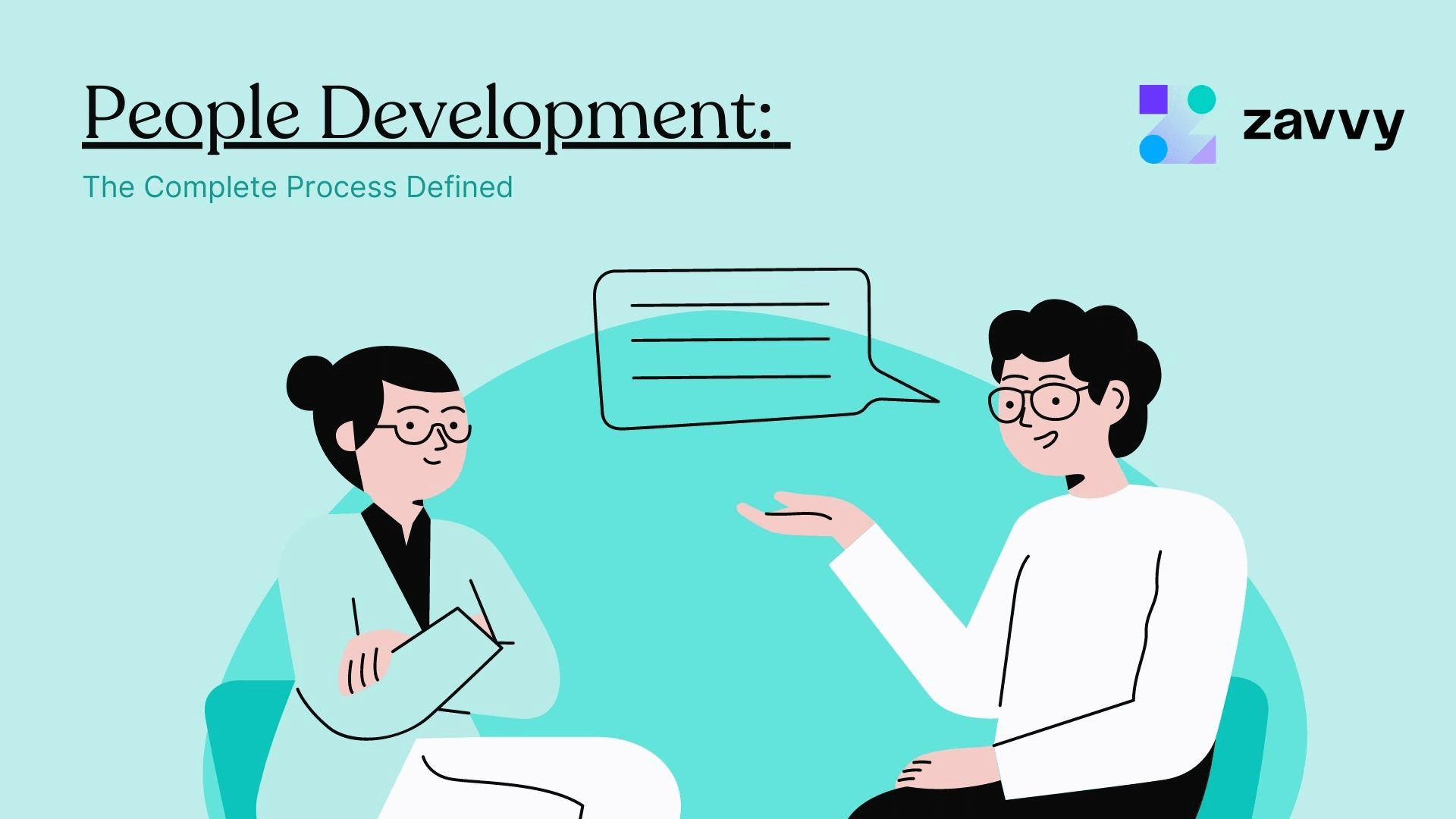
People development is taking off: a 94% increased demand for L&D specialists between July and September 2021 (compared to April to June) proves that employers now rely on internal talent to future-proof their businesses during uncertain times.
And this is a trend expected to continue, with Andrew Saidy, VP of Global Talent at Ubisoft International, explaining:
"It's unsurprising that we see more and more progressive companies naming chief learning officers – as was the case with chief diversity officers when diversity became recognized as a business advantage."
But learning and development are also important to employees, as 49% choose to stay longer at a company that invests in their growth.
During the Great Reshuffle, employees seek more than just a monthly paycheck from a job – they want to thrive in their careers too.
If you're yet to get in on the action, our guide will tell you everything you need to know about people development:
Together with our curators, we have created a library of actionable digital marketing resources. Personalized to your team's needs.
People development is the umbrella term for all activities and processes that contribute to the growth and enrichment of employees.
It's a holistic approach that encompasses four key areas:
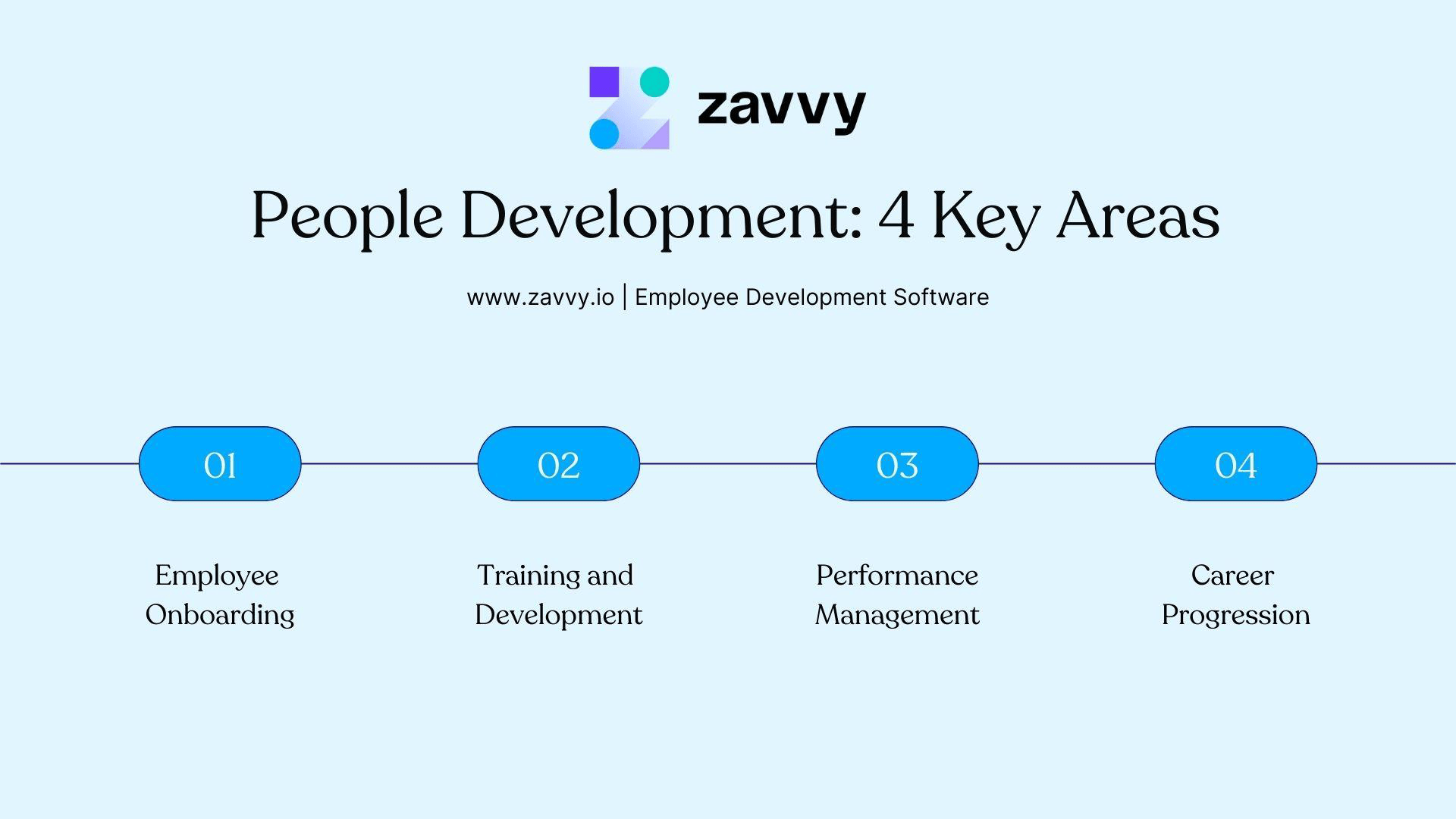
Each element is essential to ensure that employees have the skills and knowledge to do their jobs effectively.
But people development goes beyond simply ticking boxes. The essence is creating an environment where employees feel enabled and can thrive.
Companies should invest in people development, now more than ever, for the following reasons:
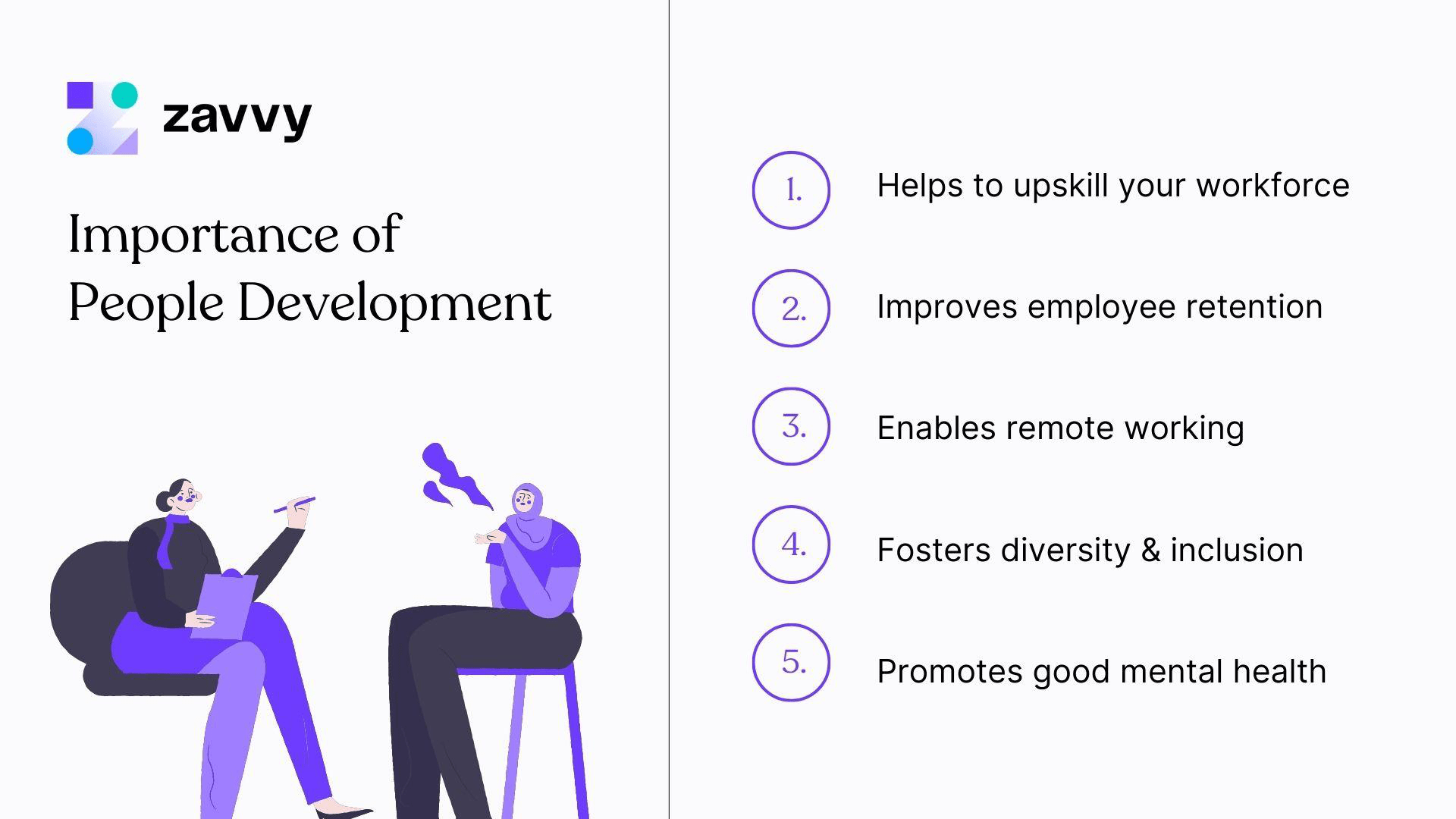
During the 2008 recession, 63% of employers cut back on learning and development. And some organizations will likely follow the same pattern of battening down the hatches to protect their bottom line in 2022.
But they could be missing a key fact.
Learning and development is an investment, allowing businesses to future-proof themselves by upskilling and reskilling their workforce. So any cutting back in this area risks employees feeling disengaged and moving on.
With the job market in full swing, employers are worried about losing their best talent to competitors.
And they should be: 44% of employees are currently job seekers, according to Willis Towers Watson's 2022 Global Benefits Attitudes Survey.
Learning and development focusing on job enrichment can help improve employee retention by ensuring employees feel valued and supported in their roles.
The surge in remote working has altered how we think about people development. Some less experienced employees miss the face-to-face interaction of growing within the office environment.
For example, in an HR Happy Hour podcast on professional and personal development, Ben Brooks from PILOT explains how the future of work is self-directed as many jobs are now changing to "thinking" jobs rather than "doing" jobs. But this personal development can be challenging in our home environments.
He explains, "Offices have a structure that helps us to perform, to stay motivated, to communicate, to maintain and grow relationships, to solve problems. We're structureless when we're working from home."
Tip: Find alternatives to traditional face-to-face training, ensuring people development encompasses virtual mentoring opportunities.
There's also an increased need for online and virtual learning solutions that allow people to develop at their own pace, allowing them to learn without reducing productivity.
DEI has been brought to the fore, and employers are now under pressure to better support employees from minority groups. Symonds Research, a training course materials provider, identifies equality, diversity, and inclusion training as a critical learning and development trend for 2022. Employers have a duty of care to provide education on critical topics like:
➡️ Discover 32 ways to promote diversity, equity, and inclusion (DEI) in your workplace.
Mental wellbeing and people development go hand in hand. Therefore, as part of any people development strategy, employers should provide training on managing stress, setting boundaries, and creating a healthy work-life balance.
Companies can also weave mental health checks into an L&D training program to ensure that the training process isn't causing any undue strain.
For example, A CIPD case study of loan providers, Pepper Group, looked at how the company upskilled and transitioned its employees to work remotely at the onset of the pandemic.
Their challenges included:
As part of this fast-track L&D program, Pepper Group leaders listened to the employee voice through weekly pulse surveys and online check-ins to ensure positive mental wellbeing.
People development should be a growth cycle, with no clear start or end point but heavily focused on continuous learning. This ongoing pull to develop doesn't subside even as we get older, progress through our careers, or reach a leadership position in our organization.
When NBA basketball champion LeBron James spoke to the New York Post, he likely didn't realize his words could be used as a people development quote, but the message is poignant. He said, "It's always about a growth mindset; it's the fact that you know you can do better, even at our age, even with our accolades, even with what we've done in our careers, we still feel like we can improve."
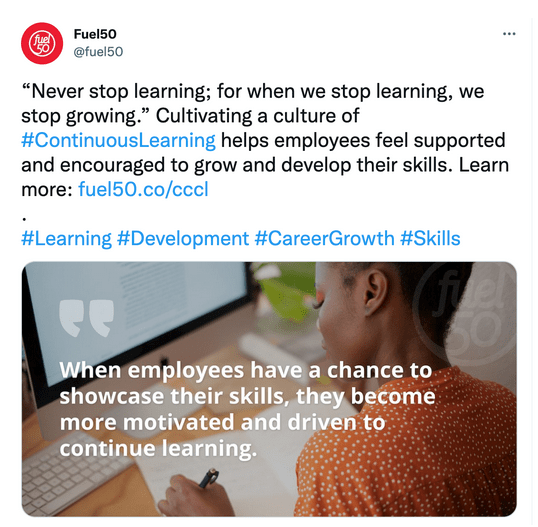
Follow this framework to implement an equally positive people development process in your organization.
Knowing that you want to invest in your employees isn't enough. You need a crystal clear people development strategy to succeed.
Use these employee development ideas to get started.
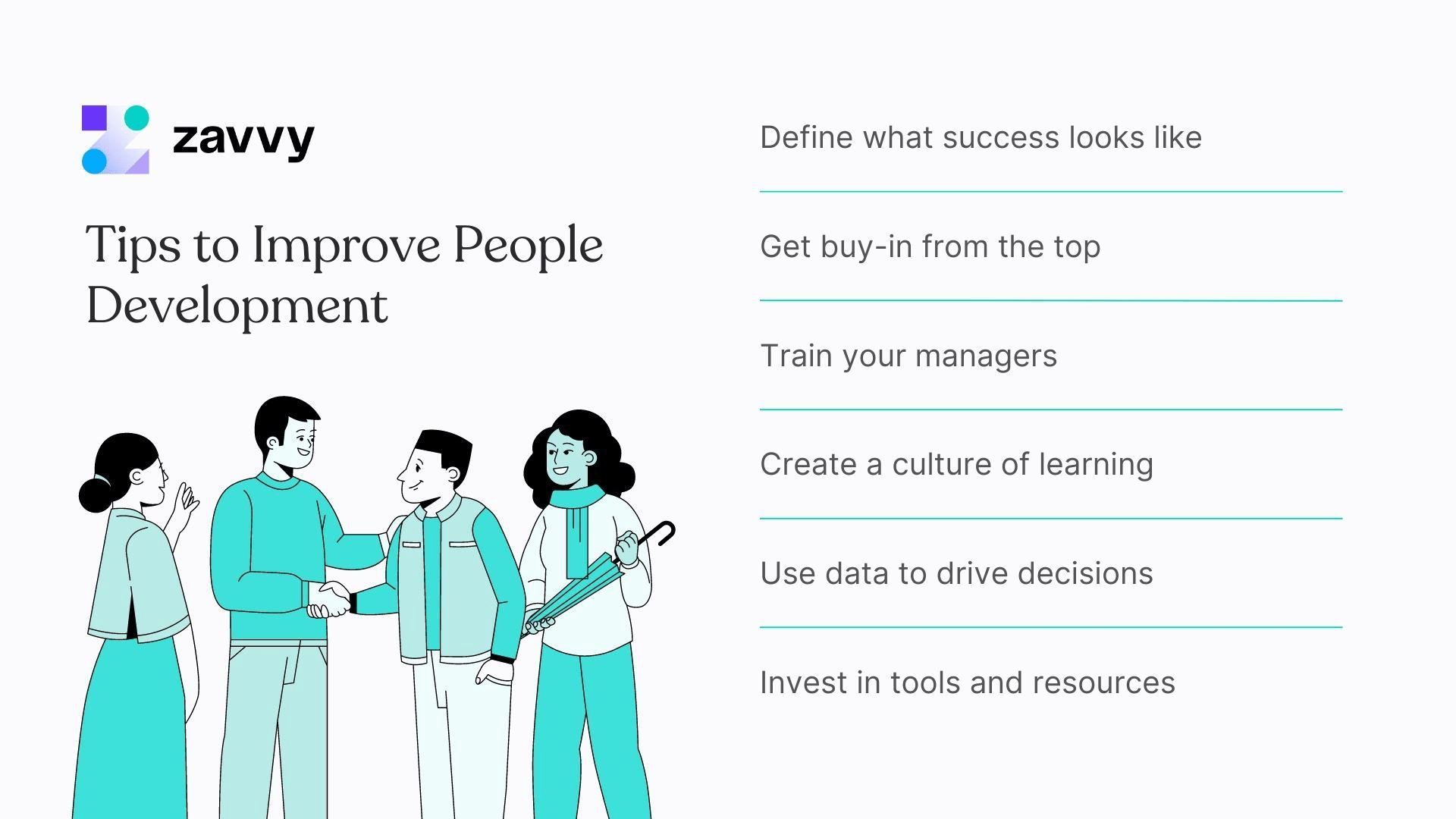
Consider what success means for your organization and each individual employee.
What skills do they need to acquire?
What behaviors do you want to see?
How will you know when they've reached the goal?
Answering these questions is key to setting up a successful people development process.
Your company's leadership must be on board with the idea of people development and its importance to the business.
Members of your C-Suite need to be willing to invest time and resources into making it happen.
People development starts with managers. They must be equipped with the skills to have difficult conversations, give feedback, and coach their team members.
Encourage employees to see learning as a lifelong activity. Create an environment where it's safe to make mistakes and challenge the status quo.
Collect data at every stage of the people development process. Use it to inform your decisions and track progress, but be flexible enough in your approach to respond to your organization's changing needs.
Give your employees the tools and 21st-century skills they need to succeed:
And make sure that these resources reach employees where they already are.
For example, push notifications to a Slack channel reminds trainees to take 5-10 minutes out of their day to commit to a microlearning session.
Create a people development plan keeping the tips above in mind. A basic template will include the employee name, title, date, and professional goals. But we suggest going beyond this wireframe and working with a more actionable and accountable strategy.
Our Zavvy employee development plan templates are available as PDF or Excel downloads.
They include:
If you're looking for a more streamlined experience, you can automate your people development plan using Zavvy's software.
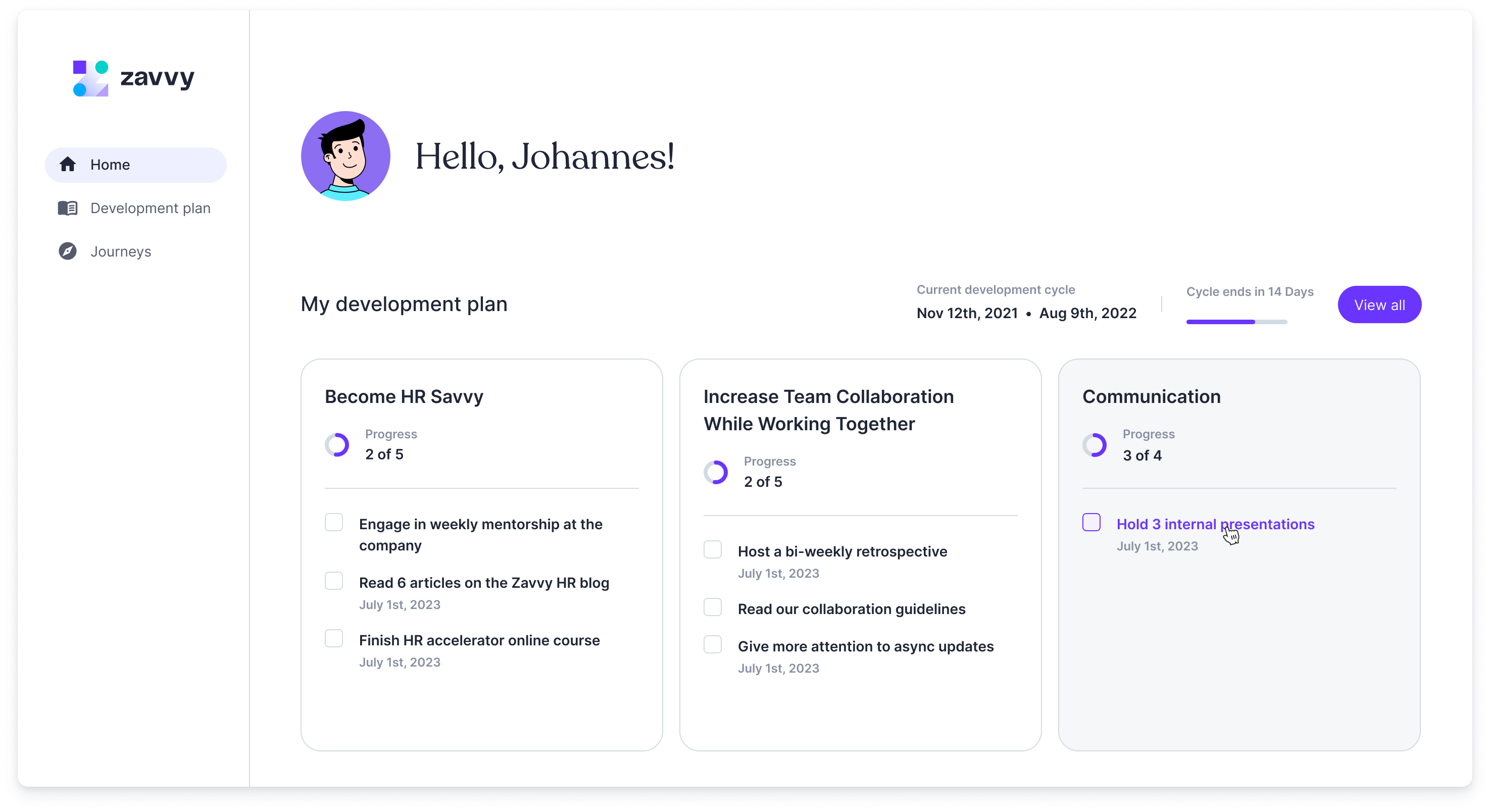
❗ 74% of employees don't believe they reach their full potential at work. Follow some of the below development methods, and you'll give them all the more reason to flourish.
Choose from on-the-job training, off-the-job training, or a blend, depending on where you believe your employees will benefit the most. Whether your trainees are learning practically or theoretically, virtual training is popular due to technological advances and the increase in remote working. Choose from virtual training styles such as:
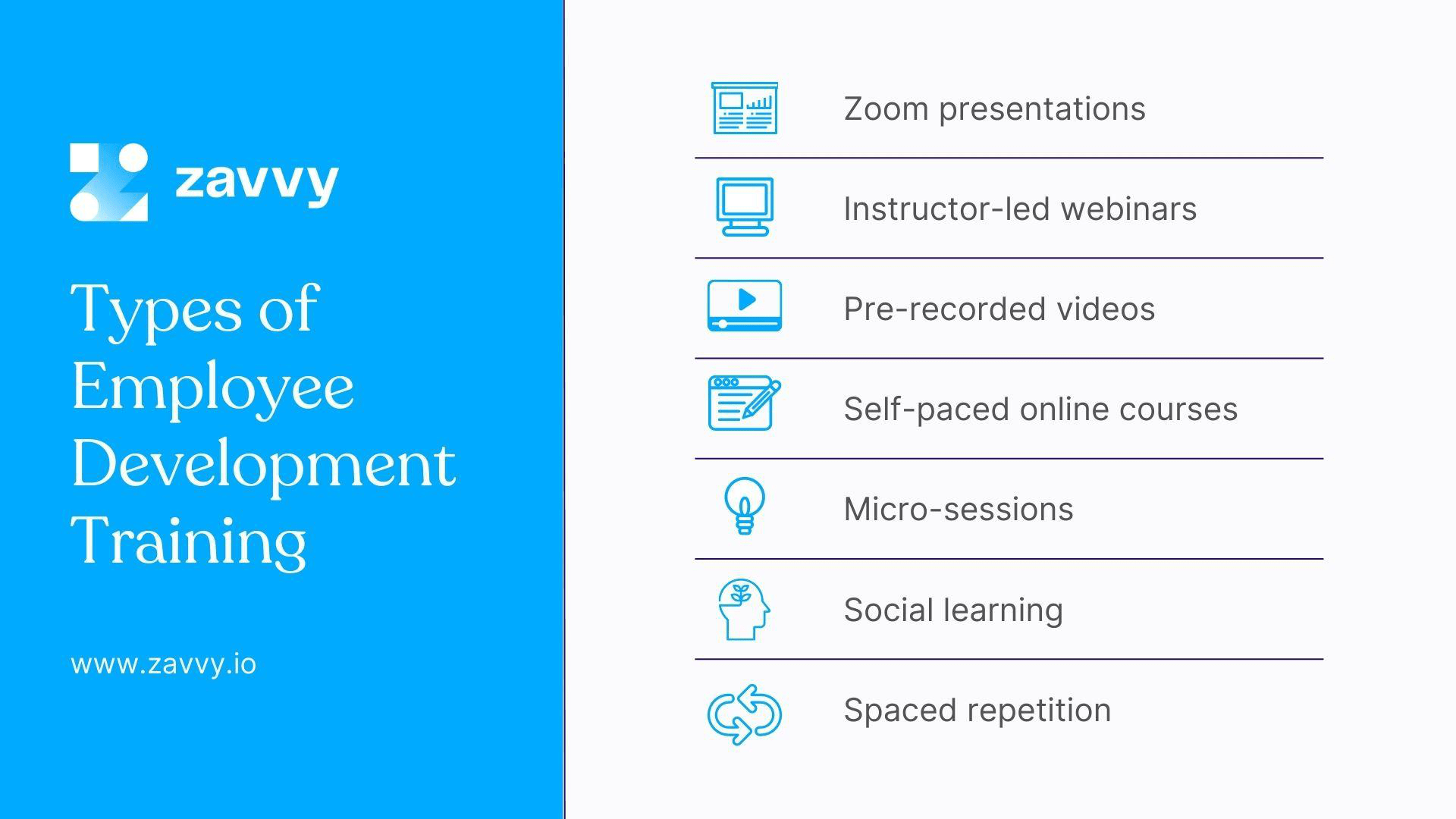
Zoom presentations are affordable to run and relatively simple to set up. You can use them for small group or one-on-one sessions.
Instructor-led webinars are an engaging format where participants ask questions in real-time.
Pre-recorded videos can be accessed on-demand and are ideal for learners who prefer to learn at their own pace. Video content is easy to consume and popular with trainees.
Self-paced online courses allow trainees to set their schedules and revisit key concepts as needed. In addition, interactive elements such as gamification and quizzes are engaging.
Microsessions are short, focused sessions (five to ten minutes in length) that are delivered virtually. As a result, employees can easily incorporate such sessions into a busy workday.
Social learning involves using online platforms or social media to connect with peers, mentors, and subject-matter experts.
Spaced repetition involves breaking down information into manageable chunks and repeating it over time. Repeating the information helps embed the new knowledge. Your employees will recall more easily what they learned.
Depending on your training style preference, digital SaaS products provide a structure for your learning program with heightened employee engagement as an added bonus.
➡️ Explore our training templates gallery. You'll access real Zavvy journeys made by our learning designers, customers, and other forward-thinking companies.
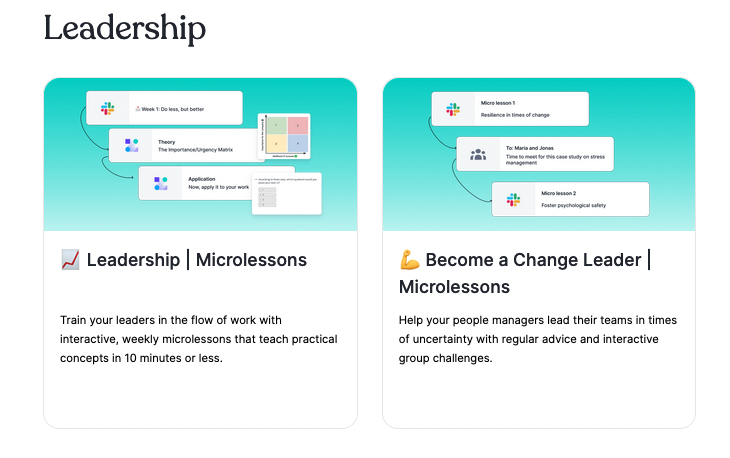
Your employee development training plan will be most effective when it's part of a broader strategy.
Consider the business goals you're trying to achieve and how your employees want to develop. You should also consider the different types of training that best suit your and your employees' needs.
Tip: Use a training needs assessment survey to get started.
Once you have a plan, monitoring progress and revising the plan as needed is important.
Tip: Review your people development plan annually or more often if you're constantly evolving your business goals.
Succession planning is the process of identifying and developing employees who have the potential to fill key leadership roles in the future. Planning for succession ensures that there is always someone with the skills and experience to step up when a leadership position becomes vacant.
Successors don't arrive in the role overnight. It takes years of talent development to groom them for their new role, which is why succession planning should be part of your broader people development strategy.
People development is critical to the growth of your organization, but some leaders mistakenly believe it takes up a lot of time.
So, why not kickstart your people development program on autopilot using Zavvy's employee development software?
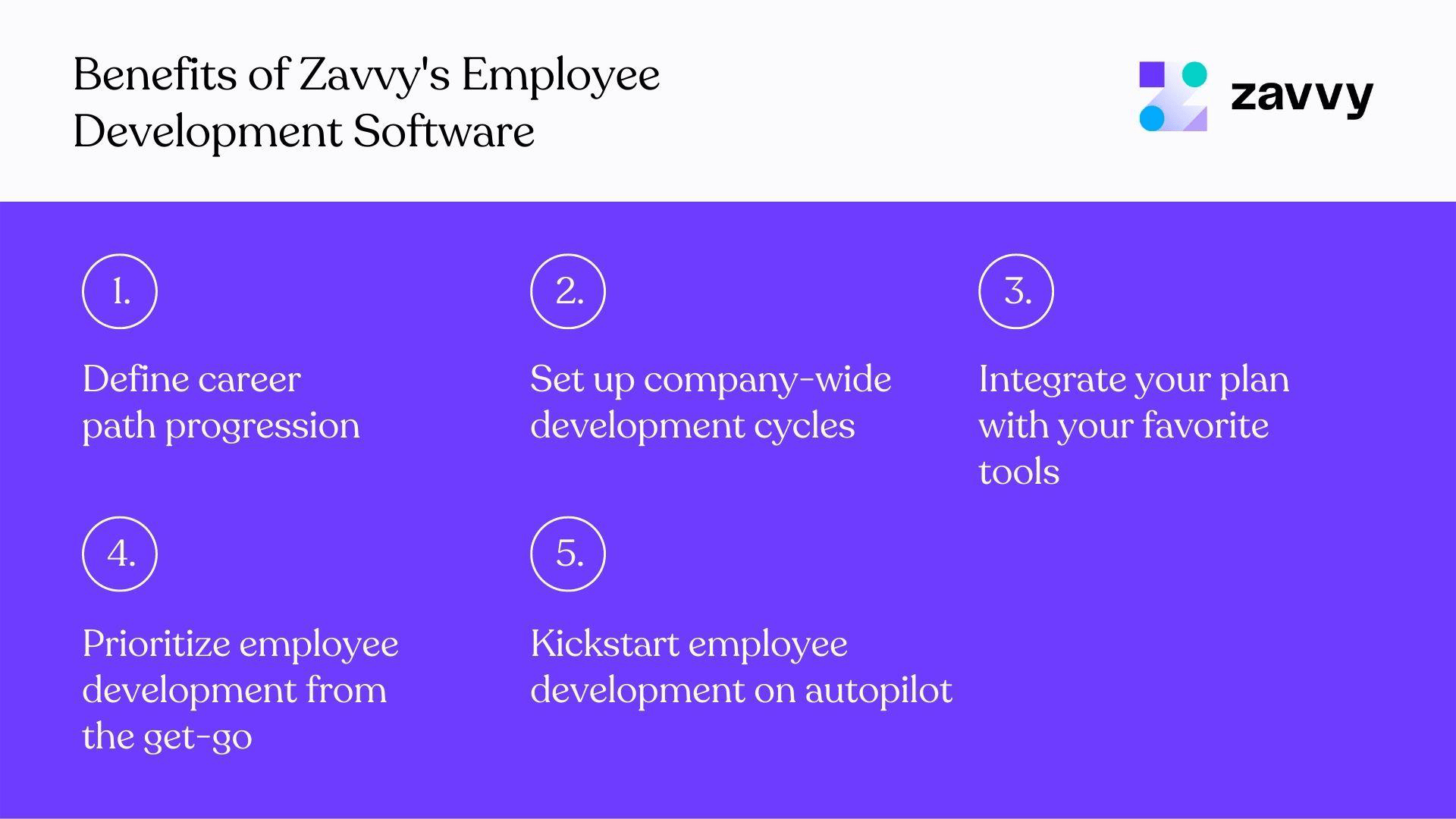
You'll:
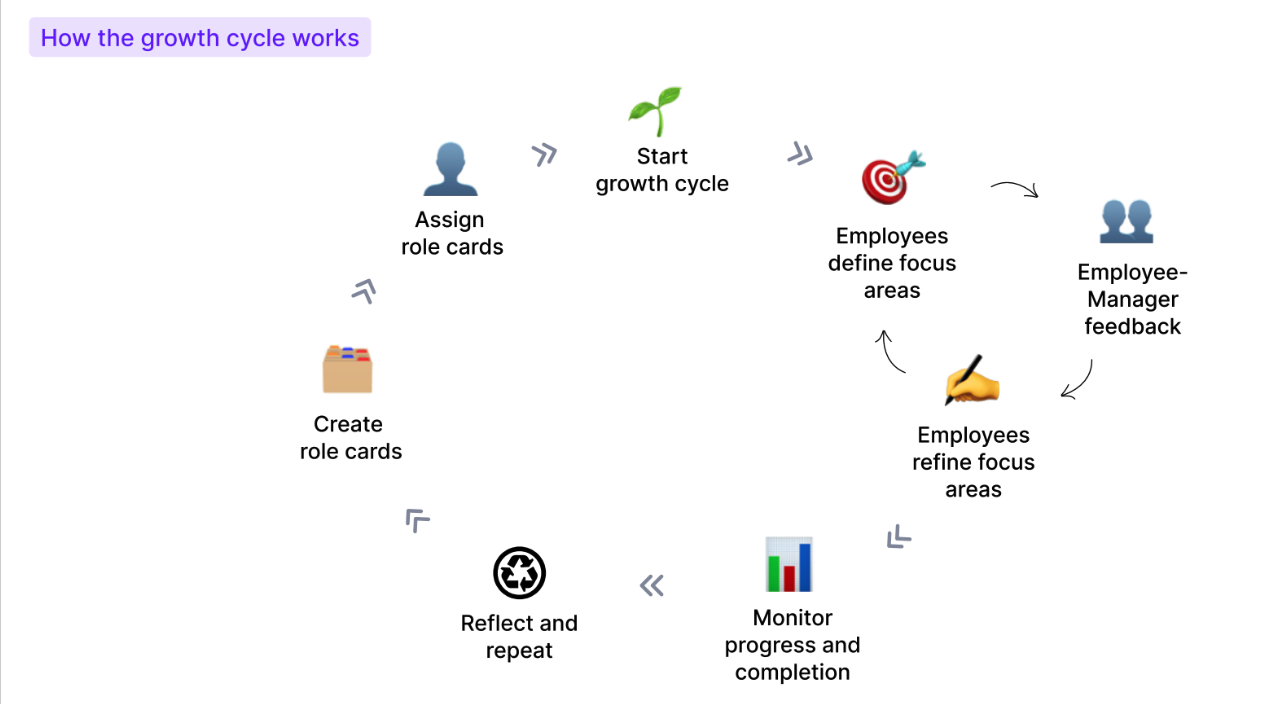
See it in action by arranging a free 30 minutes demo and consultation with Zavvy today.
Not sure about some of the people development terms we've used in this article? Check out an expanded definition of each of them here, and you'll be a People Ops L&D expert in no time at all!
On-the-job training is a hands-on, practical approach to learning that takes place as an employee performs their tasks. It is an efficient style of training where the supervisor delivers quick feedback, allowing the trainee to adjust their approach and learn "on the job."
Tip: You can enforce on-the-job training in both a physical work environment or a remote workplace, but you will need to supervise the training in both cases.
Off-the-job training focuses on knowledge acquisition rather than practical tasks.
Trainees take courses or attend workshops to learn as much information as possible before applying it to their roles.
It's a valuable approach for teaching brand-new concepts, but unfortunately, knowledge retention does drop quickly in this more formal style of training.
Job enrichment gives employees more autonomy and makes their work more interesting.
Employees should have development opportunities that broaden their skillsets and allow them to take on new tasks that they find more rewarding.
Job enrichment alleviates the Sunday Scaries where employees dread the week ahead. Most importantly, it improves employee experience.
Upskilling focuses on enhancing your employees' existing skills to bridge the gaps in your organizational lineup.
Instead of relying on recruitment, you'll invest in talent development by offering coaching, mentoring, and learning opportunities to upskill your team members and address your emerging business needs.
Reskilling differs from upskilling as it aims for employees to acquire brand-new skills for their toolbox rather than building on their existing skills.
For example, employees might try lateral skills training across a range of departments or else try out a new role entirely within the company.
A "growth mindset" is a phrase coined by Stanford University professor and researcher Carol Dweck, who believes that people develop skills and intelligence through hard work, strategies, and input from others.
The opposite is a fixed mindset, which follows the idea that learning should be effortless and you either have a knack for something or don't. Those with a growth mindset are:
It's a fluid way of thinking with unlimited learning potential.
21st-century skills move away from the idea of learning specific facts or following a set curriculum. Rather, they focus on developing abilities such as creativity, critical thinking, and collaboration which will equip employees for success in an ever-changing landscape.
Digital training (including eLearning) is at the center of 21st-century skills development, as they allow employees to learn at their own pace and apply their new skills immediately in a real-world context.
Our approach to people development skills also mirrors career planning which is no longer linear.
Just as we take lateral training to broaden our skillsets, we also move up, down, and across the organizational chart to explore new roles and gain rich work experiences.
For example, your employees can experiment with job rotations or shadowing.
Upskill your team every week with the best contents and personalized recommendations.

People development is taking off: a 94% increased demand for L&D specialists between July and September 2021 (compared to April to June) proves that employers now rely on internal talent to future-proof their businesses during uncertain times.
And this is a trend expected to continue, with Andrew Saidy, VP of Global Talent at Ubisoft International, explaining:
"It's unsurprising that we see more and more progressive companies naming chief learning officers – as was the case with chief diversity officers when diversity became recognized as a business advantage."
But learning and development are also important to employees, as 49% choose to stay longer at a company that invests in their growth.
During the Great Reshuffle, employees seek more than just a monthly paycheck from a job – they want to thrive in their careers too.
If you're yet to get in on the action, our guide will tell you everything you need to know about people development:
Get a demo!
We'll be happy to show you around and answer all your questions.
Trusted by innovative companies



We'll be happy to show you around, answer your questions, or arrange a free trial.
Erhalten Sie eine kostenlose Demo unserer Onboarding-Software.
Vertraut von



Your Training & Development Strategy - Solved in 1 Tool.
Trusted by innovative companies



We'll be happy to show you around, answer your questions, or arrange a free trial.
Learn how Zavvy helps you drive performance, development, and engagement.
Trusted by innovative companies



We'll be happy to show you around, answer your questions, or arrange a free trial.
We'll be happy to show you around and answer all your questions.
Trusted by innovative companies



We'll be happy to show you around, answer your questions, or arrange a free trial.
Gerne zeigen wir Ihnen ganz unverbindlich unsere Plattform im Detail.
Vertraut von modernen Unternehmen



Get a demo!
We'll be happy to show you around and answer all your questions.
Trusted by innovative companies



We'll be happy to show you around, answer your questions, or arrange a free trial.
Erhalten Sie eine kostenlose Demo unserer Software für Mitarbeiterenwicklung und Training.
Moderne Unternehmen
setzen auf Zavvy


